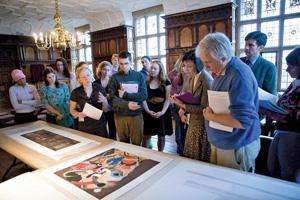 "This is a good chance to get the next Picasso before he moves out of our price range," said Katherine Eisen '12, arguing that the Mead should purchase an abstract etching [center on table] by Ahmed Alsoudani. |
Buying art for the permanent collection of a museum is a plum job usually reserved for art history Ph.D.s. But last year, Elizabeth Barker, director and chief curator of the Mead Art Museum, gave the assignment to a group of Amherst students. She asked the group—her student docents—to make the first purchase from the Trinkett Clark Memorial Student Acquisition Fund, created to memorialize the Mead’s former curator of American art, who died of cancer in 2006. The budget: $2,500.
Barker first explained to the docents that museums build their art collections not according to the personal taste of the curators but in service to the long-range needs of their institutions, weighing considerations of legality, authenticity, condition, size, quality, significance and relevance to the existing collections and to the curriculum.
Ultimately, the students decided to focus on contemporary works on paper, budget-friendly options that address a need in Amherst’s holdings. Seeking to buy locally, they examined works from several regional presses and also drove to Wingate Studio in New Hampshire, where they eventually chose three prints as finalists.
On Friday, April 3, the 16 docents presented their selections to a mock acquisitions board. The board members were Barker; Susan Anderson, interim Andrew W. Mellon coordinator of college programs; Nick Clark, widower of Trinkett Clark and chief curator of the Eric Carle Museum of Picture Book Art; Randall Griffey, curator of American art; Jill Bierly, a UMass doctoral student in anthropology who served as a volunteer coordinator for the docents; and Edward O’Connor, assistant at the Mead and also a docent coordinator.
Katherine Eisen ’12 made the case for an abstract etching by Iraqi-born Ahmed Alsoudani. “We think it’s probably a distorted human face,” she said of the 2008 untitled work, noting the “chaotic and violent” mood. “He is reacting to the horrors of war.” She said it might be a self-portrait, one that would complement the Dream and Lie of Franco etchings by Picasso and The Ravages of War print series by Goya, both in the Mead’s collection. “This is a good chance to get the next Picasso before he moves out of our price range,” Eisen concluded.
The board posed questions: What courses could make use of the print? “Because this is Amherst, we do have a class entitled, ‘War,’” Eisen said. How many prints were made? It’s the sixth impression out of 30.
Timothy Clark ’12 argued in favor of Gideon Bok’s Wingate Studios with Aldo’s Press #2, No Sleep till Hinsdale (2008), an etching and aquatint about the collaboration between artist and printer as time passes in the studio. With hollow and ghost-like figures, Clark said, the piece exemplifies Bok’s style. Clark suggested it as part of an exhibition featuring Thomas Cole’s The Past and The Present, owned by the Mead.
Barker asked, “What classes outside the art department could use this?” Chemistry courses might take interest in printmaking as a chemical process, the students said, and American studies has offerings on material culture and New England history. Also, Bok is a Hampshire College alumnus who might be willing to lecture on the piece.
Margaret Tato ’09 presented Garlic Scapes (2008), a silvery, monochromatic print by Richard Ryan that pays homage to 16th- and 17th-century Flemish still lifes. With its “smoky and elusive” grays, Tato said, the work is a strong example of the sugarlift technique—and would be the only such example in the Five Colleges. She argued that Garlic Scapes would help students learn about the evolution of sugarlift and that it would enhance exhibitions on vases, plants in art and pieces in black, white and gray.
Barker sent the students out of earshot, and the board quickly narrowed the candidates to two: the Alsoudani and the Bok. (The Ryan is a “technical marvel,” they agreed, but its light colors might disappear on the wall.) Barker described the Bok as “local in many ways” and said philosophy courses might use it to explore memory and time. Nick Clark praised the “aesthetic merit” of the Alsoudani and said the Bok would resonate with Trinkett. “I’m torn between the two,” he admitted.
A consensus reached, Barker called the docents back to the room and delivered the verdict: Bok’s work, linked to
a long history of printmaking from Rembrandt to the present, would be the inaugural student acquisition.
“Also,” Barker announced, “I have unexpected good news to share: We’ve had a very generous offer to purchase the Alsoudani as a gift to the Mead Art Museum. So that will enter the collection as well.”
The students cheered. The surprise donor, Nick Clark, smiled.
“I did it,” he said later, “because I was so impressed with those kids.”
Photo by Samuel Masinter '04